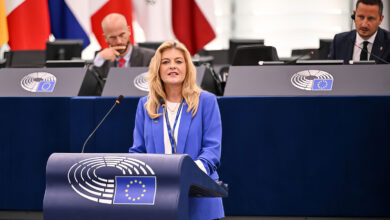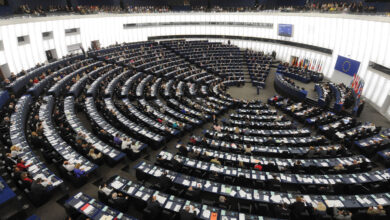Digital innovation in Estonia
 Estonia’s digital success is being closely followed across Europe. The country’s Permanent Representative to the EU, Matti Maasikas, shares its innovation story with Peter Cheney.
Estonia’s digital success is being closely followed across Europe. The country’s Permanent Representative to the EU, Matti Maasikas, shares its innovation story with Peter Cheney.
One of the EU’s smallest states has attracted attention around the world for integrating IT into its society and public services.
“We did, in the 1990s, look around us and see a lot of things that we needed to do in the world,” Estonia’s President, Toomas Hendrik Ilves, has said. “We were behind in many areas. When it came to IT … we were starting more or less at the same base as everyone else. We started with a tabula rasa – a clean slate.”
Estonia is, in population terms, similar in size to the greater Dublin area: 1.3 million compared to the city’s 1.1 million. The two areas have very different levels of GDP per capita: 145 per cent of the EU average in Dublin and 69 per cent in Estonia.
Independence was declared from Russia in 1918 but it was annexed by the Soviet Union in 1940. The state was re-established in 1991 and joined NATO and the EU in 2004.
Under the brand of ‘e-Estonia’, the Baltic state has introduced electronic voting for elections, rapid online tax returns and the ability to sign a contract through a mobile phone. Entrepreneurs can register their businesses in 18 minutes.
Matti Maasikas has been Estonia’s Permanent Representative to the EU since 2011. He sums up its main priority in Europe in one phrase: “A strong EU that knows its purpose and knows its direction.”
He continues: “I think I’d be able to argue that what is good for Europe is good for my country. This feeling of solidarity is of extraordinary effect for my country and my people. The whole membership of Estonia in the EU is a success story that has boosted investor confidence, that
has boosted the Estonian people’s confidence.”
The Ambassador sees three main reasons for Estonia’s digital success: the absence of a national infrastructure, openness to change, and the national identity card.
“When we restored our independence in 1991, in many areas we had to start from scratch,” he remarks. Other countries had maintained their statehood behind the Iron Curtain (e.g. Poland) and therefore had their own embassies, armed forces and banking systems.
“We had no burden of some outdated, old-fashioned arrangements already in place,” Maasikas says. “Why do I mention banking? We never had chequebooks. When we started banking, this phase had already been over and it meant that the same abovementioned banking sector had to start with the newest computers.”
 Electronic banking was the first digital service to be rolled out in 1996. There was an overall sense of “starting all over again” and there is still an openness and readiness “to try new things and be innovative.”
Electronic banking was the first digital service to be rolled out in 1996. There was an overall sense of “starting all over again” and there is still an openness and readiness “to try new things and be innovative.”
Ten years ago, Maasikas was its Ambassador to Finland. Estonia already had online tax declarations in place but Finland did not.
“It was not that the Finns didn’t have the technology or the code but the Finns did not feel comfortable with entrusting this to an arrangement like that,” he recalls. “That openness was one of the key factors – if not the key factor – and of course you can’t probably imagine how easy it makes life.”
His own tax return only takes three minutes to declare.
Estonia introduced mandatory identity cards in 2002 with a wide range of personal information saved on a chip: “For several years, there were not many solutions that were created to use the chip but the single fact that this opportunity was there; it enabled solutions.”
For example, everyone now has a digital signature which can be created with the card and two pin codes. This means that a prescription can be issued digitally without the citizen needing to go to their GP’s surgery.
Attempts have been to hack into the system but have proved unsuccessful. The code is “very complex” and everyone has two codes – one of four digits and the other five digits: “Each and every thing that you do with that needs those two codes.”
Estonia’s digital journey started with the innovative Tiger Leap project which started in 1996 and prioritised IT infrastructure. The education system was the first to benefit and this boosted technology skills throughout society.
The ‘X-Road’ is described as “the backbone of e-Estonia.” This infrastructure connects the nation’s databases, both in the public and private sector.
 The databases are decentralised, meaning that there’s no single owner or controller, government agencies and businesses can choose tailored products, and services can be added one at a time as they become ready. This was originally a system for making queries to the different databases.
The databases are decentralised, meaning that there’s no single owner or controller, government agencies and businesses can choose tailored products, and services can be added one at a time as they become ready. This was originally a system for making queries to the different databases.
It has since developed into a tool that can also write to multiple databases, transmit large data sets and perform searches across several databases. As one of the next steps, the Estonian IT sector is debating whether the country’s critical information systems should be moved into the cloud with supporting data centres e.g. at Estonian embassies in western countries.
“This solution would, supposedly, make occupying Estonia pointless as the country would keep securely functioning,” one civil servant remarked.
In case of an overwhelming cyber-attack, Estonia’s public e-services would be able to function from the data centres.
Talks with potential partner countries have already started and the supporters of the idea say that it would only take around two years to build what could be the world’s first ‘state cloud’.





